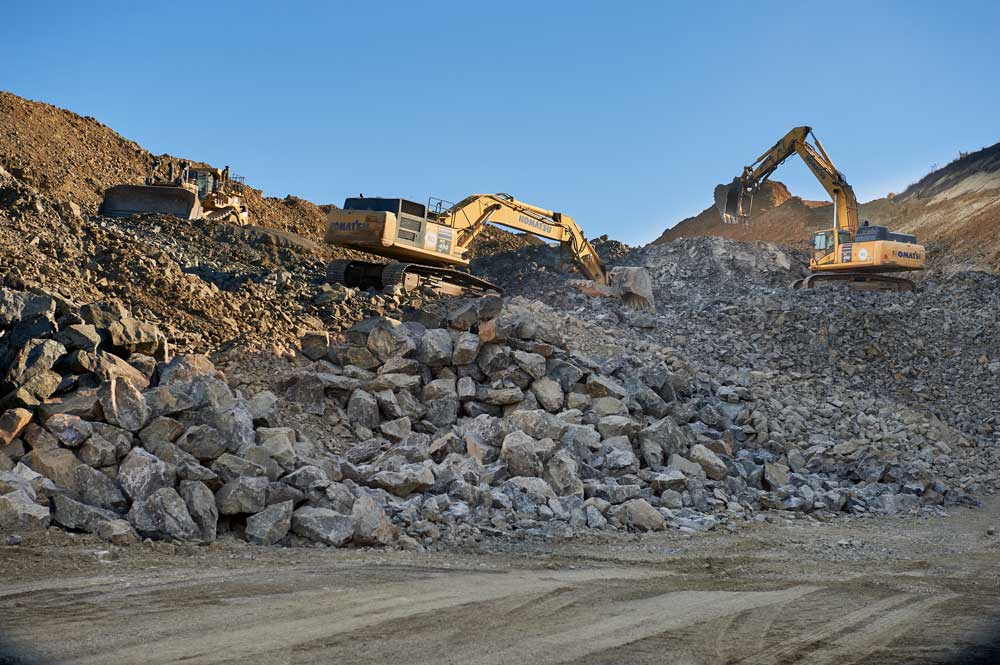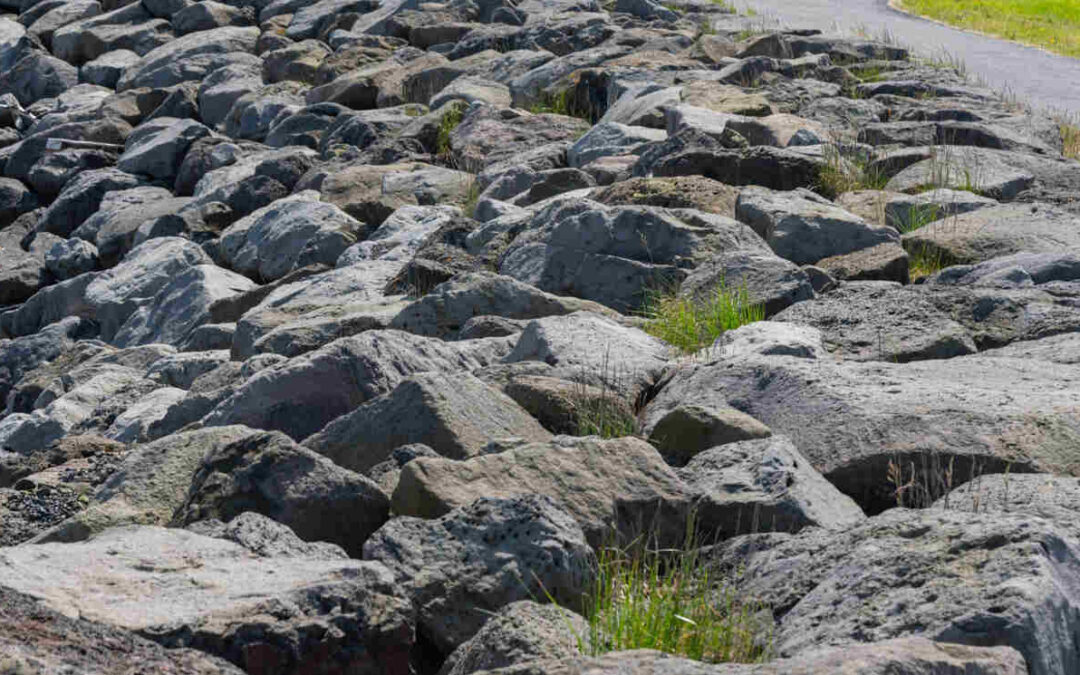As a construction and landscaping professional, you are spoiled for choice when it comes to choosing rocks and stones. Maybe you need decorative garden rocks or are looking for structural materials. You must first understand construction aggregate, which is the foundation of every construction and landscaping project.
Understanding Construction Aggregate: The Foundation of Your Project
Construction aggregate refers to the hard, granular materials that are often used in construction, either on their own or with the addition of bituminous binder, lime, or cement. Construction aggregate is derived from a number of primary sources, such as crushed rock masses or naturally occurring unbound clastic sediments like gravel aggregates and natural sand.
Construction aggregates are critical for the development and maintenance of infrastructure and large-scale projects because of their mechanical performance. Aggregates are resistant to external loads of different natures, making them fundamentally suitable for the construction of infrastructure and large-scale projects.
Crushed rock and different gravel types are known for their compressive strength, which defines their mechanical properties, and aggregate crushing value, which defines their technological-mechanical performance. Further, construction aggregate is known for its durability, making it a great choice in large-scale construction projects.
Crushed Rock vs. Other Gravel
Crushed rock is simply stone that has been crushed into smaller pieces. It is produced by breaking down large rocks, such as granite, dolomite, basalt, limestone, trap rock, and sandstone. On the other hand, gravel is a natural product of erosion and weathering.
Crushed rock is also physically different from gravel due to the crushing process that causes it to bear angled surfaces. In contrast, gravel has a more rounded look and is smaller in size.
Performance Factors for Crushed Stone and Gravel
The load-bearing capacity of a given infrastructure, such as a flexible pavement, depends on the properties of the material used in the foundation layers. Compaction properties and moisture content significantly influence the strength and deformation of construction aggregates.
Angular materials like crushed rock have a better load-bearing capacity because they have a better interlock between particles. Also, they undergo less permanent deformation when shaken down properly.
Rounded aggregates or gravel do not have the same load-bearing capacity because they do not interlock well even after a proper shakedown. The angularity of crushed rocks increases the number of contact points between particles, hence the better load distribution.

How Aggregate Specifications Impact Jobsite Performance and Bid Accuracy
Aggregates form the bedrock of a concrete’s structural integrity and, by extension, the jobsite performance. An aggregate’s origins have a significant influence on its physical and chemical characteristics, which then inform the strength and durability of the final product.
Igneous rocks are known to yield crushed rocks with higher strength because of the interlocking crystal structures formed as a result of cooling magma or lava. Conversely, sedimentary aggregates are less robust because they contain deleterious materials that could compromise the strength of a given infrastructure.
Choosing the Right Base Rock and Road Base for Structural Support
Road base refers to the materials used in the construction of parking areas, driveways, and roads. Road base serves the crucial function of providing strong structural support for the road surface, allowing it to withstand heavy traffic and changing weather conditions.
Road base evenly distributes the weight of vehicles, which then prevents the deformation or cracking of the road surface.
There are three types of road base, and they include:
- Crushed Rock: Greatly jagged in appearance, and they come in different sizes and shapes.
- Gravel: Very fine and with a generally smooth texture.
- Recycled Material: Recycled subgrade base materials, like dirt, asphalt, and concrete.
Base rock, also called crusher run, is a mix of both fine and coarse aggregate, allowing it to compact tightly. The strength of the base rock assists in soil stabilization in concrete paving and asphalt used in highways and parking lots.
There are two types of base rock, including:
- Virgin Base Rock: Blasted and processed as an aggregate directly from the mountainside.
- Recycled Base Rock: Drawn from gutters, sidewalks, and curbs. They already had life, and the rock material is torn and re-crushed to be used in other construction projects.
Subgrade material must meet engineering requirements, such as stiffness and strength. Compaction in subgrade construction increases the bearing capacity and stiffness of natural-state soils.
The compaction processes also strengthen soils by adding friction from the interlocking particles, increasing stiffness, and eliminating voids to create densified soil. Ultimately, the voids reduce the chance of the soil shrinking, expanding, or settling.
Soil moisture condition is the process of preparing the soil by reducing or increasing the moisture in the soil in readiness for construction. Too high or too low moisture levels can make the soil unstable, which can damage a foundation. Too much moisture causes swelling issues and is unsuitable for load-bearing capacity. The number one reason for foundation failures in slab-on-grade foundations is soil expansion.
Still, the right base material can save time and money that could be spent on rework. Material selection ultimately affects the cost of a construction project through the price of raw materials, processing expenses, and the longevity of a construction project. Specialized materials cost more upfront, but they save money in the long run by lasting longer.
Drainage Rock and Gravel Types: Solving Water and Site Management Issues
Poor drainage can jeopardize the structural integrity of commercial sites. Poor drainage causes soil expansion and contraction, and the cyclical movement is called heaving and settling. It places excess stress on the foundation and can eventually crack, shift, or break off the foundation material.
Poor drainage also causes hydrostatic pressure, causing walls to crack and bow inward. In worse circumstances, the foundation leaks or fails structurally and requires major rework.
Fractured rock is the best drainage rock for retaining walls, trenching, and erosion control. Compared to rounded pebble rocks, fractured rocks have angular edges that create a more stable structure that locks well together. These angular pieces allow water to flow through easily, and the drainage rock does not have to shift or settle.
There is a need for considerations for sizing, permeability, and placement in jobsite planning regarding drainage rock and gravel types.
- Small aggregates, measuring around 10 mm, are a suitable gravel type for filtration, reducing clogging, and soil protection. However, small aggregates can restrict the flow of water and require constant maintenance.
- Medium aggregates measuring about 40 mm offer a better balance between drainage speeds and filtration, making them the best base rock for long-term drainage solutions.
- Large aggregates measuring more than 40 mm are suitable for areas that need rapid drainage as a result of excess rainfall, such as roads and sports fields.

Bulk Landscaping Stone and Decorative Rock for Large-Scale Design
In addition to enhancing the foundational structure of construction projects, construction aggregates can be used as landscaping stone, decorative rock, and drainage rock.
Landscaping stones and decorative rocks are used in almost every area of the home, public works, parks, and business complexes as attractive ground covers and for practical purposes as well.
Landscaping stones are good for small landscaping jobs, such as decorative accents or mulch around a shrub. Landscaping rocks are more suitable for larger jobs, such as decorating a long driveway or walkway.
Even better, there are benefits that go beyond appearance, including:
- Lava rocks are good as drainage rocks because they absorb heat and let it out into the air.
- Drainage rocks are low maintenance, and there is no need for constant raking, as in the case of mulch.
- Drainage rocks boost soil health by allowing the soil to breathe better.
Logistics of Sourcing Bulk Quantities
Soil, mulch, and drainage rocks are materials that should be sourced in bulk quantities for large-scale landscaping projects. Before committing to a supplier, a little research is considered critical. Evaluate their reputation and customer reviews. Get a variety of suppliers, but getting your bulk landscaping materials under one roof will simplify your procurement and logistics.
Selecting the Right Rock Supplier: Ensuring Consistency, Volume, and Service
Reliable rock suppliers for construction aggregate, road base, and gravel types are what you need to ensure consistency, volume, and service in your landscaping and construction project. A reliable rock supplier is identifiable as follows:
- Quality Assurance: A reliable rock supplier guarantees quality in their processes, starting with their procurement to the delivery process.
- Product Variety: Good suppliers offer a wide range of rock sizes, grades, and types to meet the needs of commercial projects.
- On-time Delivery: Reliable delivery is critical for commercial orders, and a good supplier must have a good track record and a working supply chain management.
- Competitive Pricing: Competitive pricing is crucial for commercial projects, and reliable suppliers offer fair and transparent pricing structures.
Consistent aggregate gradation is critical in every construction project. Aggregate gradation refers to the measurement of the range of sizes that make up a sample of aggregate. Aggregate rock suppliers must have the right testing documentation and material certification showing how they ensure a proper balance of fine and coarse particles in their aggregate materials.
Delivery costs are a constant reality in the construction industry. Here are a few tips on how to enhance delivery logistics in time-sensitive bids.
- Careful planning and execution, starting from truck size, site access, delivery distance, and materials volume.
- Sourcing locally whenever possible.
- Leveraging rail transport for large jobs.
- Bundling orders to reduce the number of trips.
Form long-term supplier relationships to streamline project planning and pricing by enhancing collaborations and efficiency and reducing uncertainty. These relationships are also good for better communication, favorable pricing, and consistent quality.
Get in touch with Roblar Quarry today to choose the right rock for your next construction or landscaping project. We look forward to building a supplier relationship with you.
